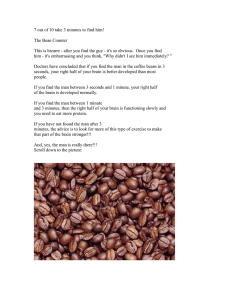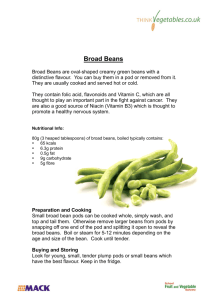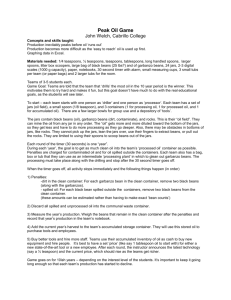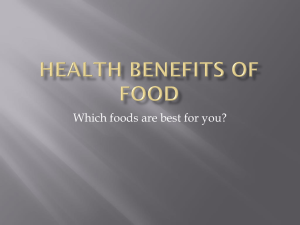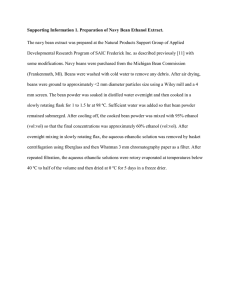Garbonzo Bean Food $ense Kids
advertisement
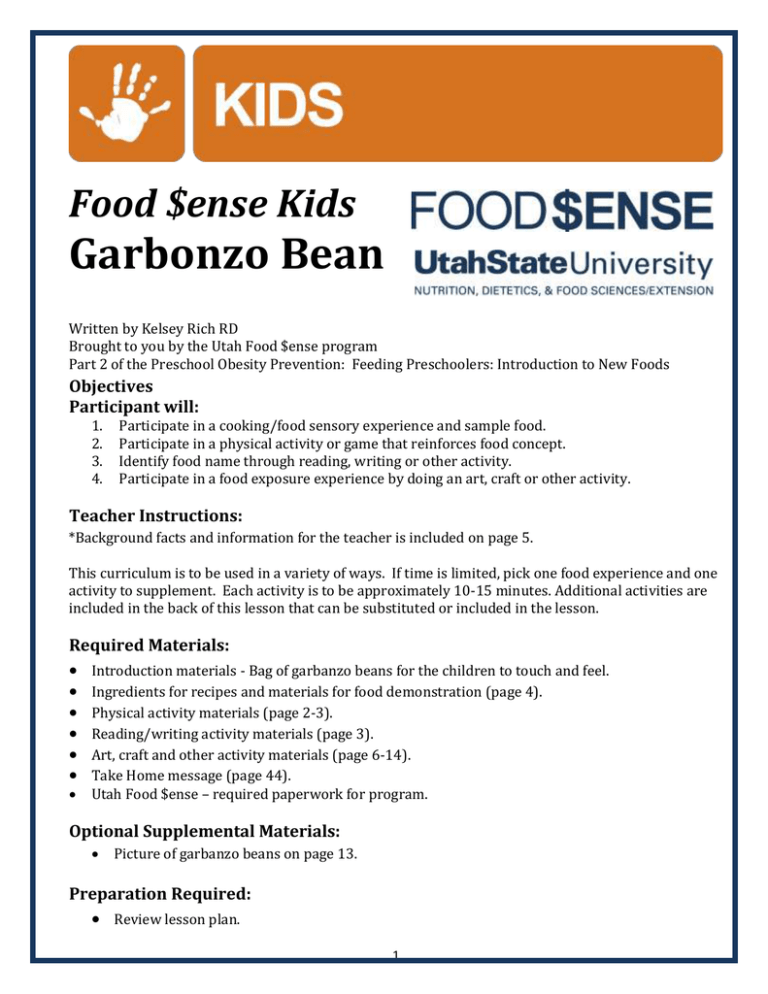
Food $ense Kids Garbonzo Bean Written by Kelsey Rich RD Brought to you by the Utah Food $ense program Part 2 of the Preschool Obesity Prevention: Feeding Preschoolers: Introduction to New Foods Objectives Participant will: 1. 2. 3. 4. Participate in a cooking/food sensory experience and sample food. Participate in a physical activity or game that reinforces food concept. Identify food name through reading, writing or other activity. Participate in a food exposure experience by doing an art, craft or other activity. Teacher Instructions: *Background facts and information for the teacher is included on page 5. This curriculum is to be used in a variety of ways. If time is limited, pick one food experience and one activity to supplement. Each activity is to be approximately 10-15 minutes. Additional activities are included in the back of this lesson that can be substituted or included in the lesson. Required Materials: Introduction materials - Bag of garbanzo beans for the children to touch and feel. Ingredients for recipes and materials for food demonstration (page 4). Physical activity materials (page 2-3). Reading/writing activity materials (page 3). Art, craft and other activity materials (page 6-14). Take Home message (page 44). Utah Food $ense – required paperwork for program. Optional Supplemental Materials: Picture of garbanzo beans on page 13. Preparation Required: Review lesson plan. 1 Review teacher background information. Gather ingredients and materials needed to demonstrate the recipe (see page 4). Make copies of pictures for Silly Bean Song on pages 8-12. Make copies of recipes and take home messages handout you wish to distribute (see page 4) – enough for all class participants to take home to families. Utah Food $ense - Make copies of all required paperwork for lesson. LESSON PLAN Introduction Time: 5 minutes Fill a small bowl with dried or canned garbanzo beans and pass it around. Allow the children to touch and smell the beans. You may also want to give each child a few beans and allow them to play with and squish the beans. Ask the children to describe how the garbanzo beans feel. Explain that these beans have two names, chickpeas or garbanzo beans. (You can use pages 28 and 29 of the book Life Cycle of a Bean by Angel Royston to discuss the life cycle of a bean plant. Explain that garbanzo beans need lots of rain and sunshine to grow.) Show picture of garbanzo bean pods (page 7). Explain that they grow in a pod on plants, and depending on where they are grown; chickpeas can be either green or white. Tell the children that these beans are good for us to eat. The help us grow, give us energy, and are very good for our body (They are high in protein and fiber, and low in fat). Chickpeas are used to make a tasty food called hummus. Ask the children: Have you ever had hummus before? Chickpeas can also be used in salads, soups, or sandwiches. Objective 1: Participate in a cooking/ food sensory experience and sample food. Time: 10 minutes Choose a recipe that will work for your lesson (page 4): Classic Hummus with vegetables or pita bread Honey Roasted Garbanzo Beans Chickpea Salad If possible, allow the children to help combine the ingredients. Make sure they wash their hands thoroughly before they handle any food. Objective 2: Participate in a physical activity or game that reinforces food concept. Time: 10 minutes Bean Bag Toss Get a large bowl(s) or container(s). Give each child 3 bean bags and have them take turns trying to throw the bean bags into the container(s). Mark three different distances away from the containers on the floor with masking tape. Allow the children to try to make a basket from all three distances. Objective 3: Identify food name through a reading, writing or other activity. Time: 10-15 minutes Read the children “Skippyjon Jones” by Judy Schachner. 2 On the page (~page 19) where it talks about the beans Bandito steals, you can add garbanzo beans to the list. _____________________________________________________________________________________________ Objective 4: Participate in a food exposure experience by doing an art, craft, or other activity. Time: 10 minutes Use the pictures on pages 7-12 to sing the Silly Bean Song (to the tune of I’m a Nut): My dog (bean type) likes to roam, One day (bean type) left his home. He came back so nice and clean, Where, oh where had (bean type) been? (Bean type) Bean! (Bean type) Bean! (Bean type) Bean! You can have 6 children hold up the pictures in front of the class, as they learn/sing the song. _________________________________________________________________________ Conclusion: Time: 5 minutes Discuss why garbanzo beans (chickpeas) are good for our bodies. Healthy légume that helps us grow, gives us energy, and is good for our bodies. What foods can we make with garbanzo beans? hummus, soups, falafel, salads. Resources : http://en.wikipedia.org/wiki/Hummus http://en.wikipedia.org/wiki/Chickpea http://www.foodnetwork.com/recipes/rachael-ray/chickpea-salad-recipe/index.html Classic Hummus Recipe – courtesy of Tammy Vitale RD http://www.flickr.com/photos/superdupermanda/4662645736/ http://www.adogabouttown.com/?m=200812 http://www.faqs.org/photo-dict/phrase/8744/garbanzo-beans.html http://www.treehugger.com/files/2009/10/grateful-dog-is-sacramentos-first-green-dog-day-care.php http://www.pensionriskmatters.com/articles/pension-benefit-guaranty-corpo/ http://www.ingoodfeather.com/2010/03/caffeinated-soap-an-alternative-to-drinking-coffee/ http://woodworkingcarpentry.info/ContactUs.htm This material was funded by USDA’s Supplemental Nutrition Assistance Program – SNAP. The Supplemental Nutrition Assistance Program (SNAP) provides nutrition assistance to people with low income. It can help you buy nutritious foods for a better diet. To find out more, contact 1800-221-5689 or visit online at http://www.fns.usda.gov/snap/. In accordance with Federal Law and U.S. Department of Agriculture policy, this institution is prohibited from discriminating on the basis of race, color, national origin, sex, age, religion, political beliefs or disability. To file a complaint of discrimination, write USDA, Director, Office of Civil Rights, 1400 Independence Avenue, S.W., Washington, D.C. 20250-9410 or call (800)795-3572. 3 RECIPES TOPIC: Garbanzo Beans Classic Hummus Ingredients 2 C garbanzo beans, canned, drained and rinsed 2/3 C tahini ¾ C lemon juice 1 teaspoon salt 2 cloves garlic ¼ C red pepper (optional, for color) Directions: Place all ingredients in food processor or blender. Chill prior to serving if time allows. Serve with pita bread wedges or fresh vegetables. Yield: about 2 1/2 cups Chickpea Salad Ingredients 2 (15-ounce) cans chickpeas, rinsed and drained 1 small red onion finely chopped 1 small red bell pepper, finely chopped 1 C. chopped cucumber 1 clove garlic, minced or grated then grinded into a paste with salt 2 tablespoons rosemary, finely chopped, a few sprigs 2 tablespoons red wine vinegar 3 tablespoons extra-virgin olive oil Salt and freshly ground black pepper 1 lemon, juiced Directions Combine chick peas with onions, peppers, cucumbers, garlic, and rosemary in a medium bowl. Dress salad with vinegar and oil, salt and pepper, and lemon juice. This material was funded by USDA’s Supplemental Nutrition Assistance Program – SNAP. The Supplemental Nutrition Assistance Program (SNAP) provides nutrition assistance to people with low income. It can help you buy nutritious foods for a better diet. To find out more, contact 1800-221-5689 or visit online at http://www.fns.usda.gov/snap/. In accordance with Federal Law and U.S. Department of Agriculture policy, this institution is prohibited from discriminating on the basis of race, color, national origin, sex, age, religion, political beliefs or disability. To file a complaint of discrimination, write USDA, Director, Office of Civil Rights, 1400 Independence Avenue, S.W., Washington, D.C. 20250-9410 or call (800)795-3572. 4 Honey Roasted Garbanzo Beans Ingredients 1 can garbanzo beans, drained and rinsed 2 tablespoons honey 1 teaspoon olive oil 1/2 teaspoons salt Directions Preheat oven to 425F. Placed beans on a baking sheet. Evenly spread honey and oil over the beans. Mix the beans with hands to ensure all beans get honey/oil mixture. Lightly sprinkle salt over all the beans. Cook beans for 20 minutes or until light brown. Let cool for a minute prior to serving. DID YOU KNOW? Garbanzo beans are also called chickpeas. Garbanzo beans only grow in environments that receive a lot of rain and sunshine. Garbanzo beans are good sources of fiber and protein. Garbanzo beans are low-fat. This material was funded by USDA’s Supplemental Nutrition Assistance Program – SNAP. The Supplemental Nutrition Assistance Program (SNAP) provides nutrition assistance to people with low income. It can help you buy nutritious foods for a better diet. To find out more, contact 1-800-221-5689 or visit online at http://www.fns.usda.gov/snap/. In accordance with Federal Law and U.S. Department of Agriculture policy, this institution is prohibited from discriminating on the basis of race, color, national origin, sex, age, religion, political beliefs or disability. To file a complaint of discrimination, write USDA, Director, Office of Civil Rights, 1400 Independence Avenue, S.W., Washington, D.C. 20250-9410 or call (800)795-3572. 5 Preschool Curriculum Garbanzo Beans Background Teaching Information History: The chickpea is also known as the garbanzo bean, Indian pea, ceci bean, Bengal gram. Chickpeas are a legume. Garbanzo is the old Spanish name for chickpea. Chickpeas are high in protein and one of the earliest cultivated vegetables. 7,500-year-old remains of garbanzo beans have been found in the Middle East. Nutrition: Chickpeas are a helpful source of zinc, folate and protein. They are also very high in dietary fiber. Chickpeas are low in fat. One-half cup of chickpeas o Has only 135 calories. o Provides fiber, iron, calcium, and potassium o Has no cholesterol. Uses: Chickpea seeds are eaten fresh as green vegetables, parched, fried, roasted, broiled, in snack foods and condiments, and their flour can be used as soup, dhal, and to make bread. Growing/Harvesting: The plant grows to between 20 and 50 cm high and has small feathery leaves on either side of the stem. Chickpeas are a type of pulse, with one seedpod containing two or three peas. It has white flowers with blue, violet or pink veins. Chickpeas need a subtropical or tropical climate with more than 400 millimeters (16 in) of annual rain. They can be grown in a temperate climate but yields will be much lower. Chickpeas are grown in the Mediterranean, western Asia, the Indian subcontinent and Australia. Resources: http://en.wikipedia.org/wiki/Chickpea http://www.monosar.org/policies_2008_02_06.html http://wellnessways.aces.illinois.edu/newsletters/Beans-Chickpeas.pdf http://www.ampc.montana.edu/briefings/briefing55.pdf This material was funded by USDA’s Supplemental Nutrition Assistance Program – SNAP. The Supplemental Nutrition Assistance Program (SNAP) provides nutrition assistance to people with low income. It can help you buy nutritious foods for a better diet. To find out more, contact 1-800-221-5689 or visit online at http://www.fns.usda.gov/snap/. In accordance with Federal Law and U.S. Department of Agriculture policy, this institution is prohibited from discriminating on the basis of race, color, national origin, sex, age, religion, political beliefs or disability. To file a complaint of discrimination, write USDA, Director, Office of Civil Rights, 1400 Independence Avenue, S.W., Washington, D.C. 20250-9410 or call (800)795-3572. 6 Garbanzo Bean Pods 7 = My Dog Garbanzo 8 Likes to Roam 9 One day Garbanzo left his home 10 He came back so nice and clean 11 Where, oh where had Garbanzo been? 12 Garbanzo Bean! Garbanzo Bean! Garbanzo Bean! 13 14
